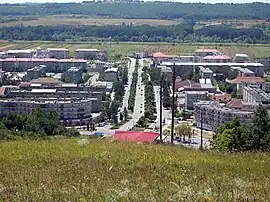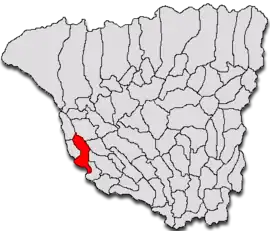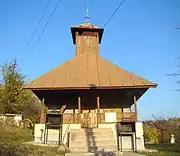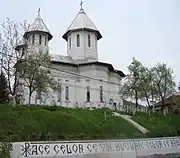Motru | |
|---|---|
 View over the city from Motru Hills | |
 Coat of arms | |
 Location in Gorj County | |
 Motru Location in Romania | |
| Coordinates: 44°48′13″N 22°58′15″E / 44.80361°N 22.97083°E | |
| Country | Romania |
| County | Gorj |
| Government | |
| • Mayor (2020–2024) | Costel-Cosmin Morega[1] (PSD) |
| Area | 50.09 km2 (19.34 sq mi) |
| Elevation | 185 m (607 ft) |
| Population (2021-12-01)[2] | 15,950 |
| • Density | 320/km2 (820/sq mi) |
| Time zone | EET/EEST (UTC+2/+3) |
| Postal code | 215200 |
| Area code | (+40) 02 53 |
| Vehicle reg. | GJ |
| Website | www |
Motru (Romanian pronunciation: [ˈmotru]) is a city in Romania, Gorj County. It is situated on the river Motru and its tributary, the river Ploștina, in western Oltenia. The county capital Târgu Jiu is located about 35 km (22 mi) northeast. The city administers eight villages: Dealu Pomilor, Horăști, Însurăței, Leurda, Lupoița, Ploștina, Roșiuța, and Râpa.
History
| Year | Pop. | ±% |
|---|---|---|
| 1977 | 15,998 | — |
| 1992 | 26,626 | +66.4% |
| 2002 | 25,860 | −2.9% |
| 2011 | 18,142 | −29.8% |
| 2021 | 15,950 | −12.1% |
| Source: Census data | ||
Motru was created by an administrative decision on 24 May 1966 on the territory of the former Ploștina commune, which, together with seven other villages, became part of the new city. The reason behind the decision to create a city was the development of several coal deposits.
The region is at least since the time of the Roman Empire inhabited, in Leurda in 1964, some silver coins from the era of Emperor Septimius Severus (193–211) were found. The oldest documented settlement in the territory of present-day town Ploștina (1385 is mentioned).
The Dacian town Amutria is mentioned in ancient sources like Ptolemy's Geographia (c. 150 AD) and Tabula Peutingeriana (2nd century AD), and potentially placed here.[3] The name is homonymous with the ancient name of the Motru River.[3] After the Roman conquest of Dacia, Amutria was part of an important road network, between Drubetis and Pelendava.
In 1981, Motru was the site of riots from miners who were working in the mines of the city. The riots, which took place between 17 and 19 October of that year, were triggered by poor work conditions, tight control of legislative organizations and the general exhaustion of the miners, further exacerbated by a decree that limited consumption of bread only to the dwellers of the city. During the riots, Emil Bobu visited the city, where he was attacked by angry crowds with potatoes; when he returned to Bucharest, he ordered the army to intervene in the city after 2 days of protests from the local populace. At the time, the inexpensive Motru bread attracted many workers and farmers into the city, who carried the bread loafs in sacks and arrived in the town by local trains known as "trains of hunger". Nowadays the bread factory is in ruins.[4]
Present
In today's incorporated villages were partially free farmers, others were in the monastery Tismana submissive.
Motru was declared a municipiu in 2000.
Mining is the city's main industry; agriculture and livestock are also important, especially in its attached villages.
At the 2021 census, Motru had a population of 15,950. At the 2011 census, the population was 18,142, including 17,988 Romanians, 38 Hungarians, 83 Roma, and 3 Germans.
Transportation
Motru is the terminus of a railway line that branches off the CFR main line Bucharest–Craiova–Lugoj at Strehaia, which was put into operation in 1962. Several times a day commuter trains travel to Craiova. In addition, there are bus connections with the county seat of Târgu Jiu. Motru is on the National Road DN67 from Drobeta-Turnu Severin to Râmnicu Vâlcea.
Natives
- Gabriel Cruceru (born 1989), footballer
- Marcus Graham (1893–1985), anarchist active in the United States
- Dorel Mutică (born 1973), footballer
See also
Notes
- ↑ "Results of the 2020 local elections". Central Electoral Bureau. Retrieved 14 June 2021.
- ↑ "Populaţia rezidentă după grupa de vârstă, pe județe și municipii, orașe, comune, la 1 decembrie 2021" (XLS). National Institute of Statistics.
- 1 2 Schütte 1917, p. 96.
- ↑ Ion, Alin (September 22, 2017). "Care a fost adevăratul tren al foamei și de unde provine porecla primită". Adevărul (in Romanian). Retrieved December 24, 2023.
References
- Schütte, Gudmund (1917). Ptolemy's maps of northern Europe: a reconstruction of the prototypes. Copenhagen: H. Hagerup.
 Wooden church in Horăști
Wooden church in Horăști.jpg.webp) Wooden church in Leurda
Wooden church in Leurda.jpg.webp) Church of the Dormition in Lupoița
Church of the Dormition in Lupoița Church in Roșiuța
Church in Roșiuța